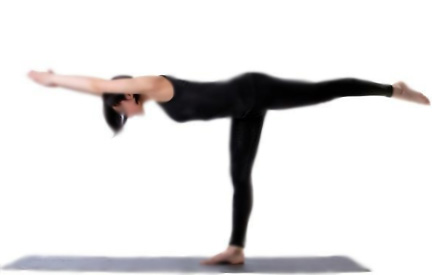
Posture:Ekapada-asana – The One–legged Posture
Translation:The Sanskrit word eka means one and pada means foot making this the one-foot, or more commonly one-legged pose.
Pronunciation:eka-pod-ah-sa-nas
Difficulty:(5)
Instructions:
- Stand with the feet together and the arms by your sides (see the tad-asana).
- Focus the eyes straight ahead on a spot midway between waist and eye level and remain focused there throughout this asana. (standing about five feet from a wall would be helpful).
- Inhale and extend the arms directly in front, parallel with the floor with thumbs touching.
- Exhale and raise the right knee bending the leg at a 90 degree angle, pause for a moment then extend the leg straight out in front pointing the toes forward.
- Pause for a moment then swing the leg backward while bending forward at the waist.
- Breath slowly through the nostrils and make sure the arms, torso and legs are parallel with the floor.
- Hold the posture for at least 30 seconds and then return slowly to a standing position.
Comments:
The ekapada-asana tones and strengthens leg muscles, improves sense of balance and helps sharpen concentration.
The ekpada requires that you become aware of your body/mind as a whole. As you practice this posture turn the attention away from distractions of the mind and center it on full body-awareness. Continual effort in the ekpada-asana in this way will help cultivate concentration.
The "closed eyes" variation (see below) intensifies the effect of the posture. Instead of relying on a fixed point of vision as an "anchor" the practitioner will cultivate an inner stability. The ekpada-asana also gives strength to the hips and lower back.
Duration/Repetitions:
This posture should be held for a minimum of 30 seconds and can be extended to up to several minutes. Repeat at least twice on each foot.
Variations:
When you can remain in the ekpada effortlessly for at least 30 seconds without wavering or losing balance, try doing it with the eyes closed. This variation makes the posture quite challenging but it increases the benefits as described above.


